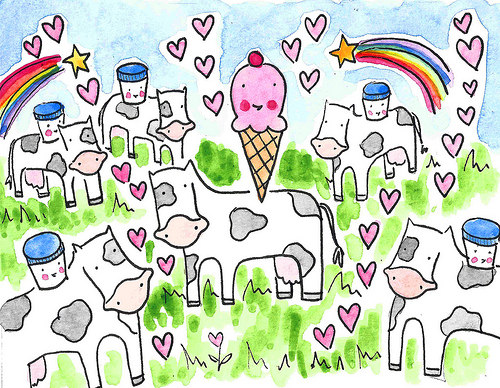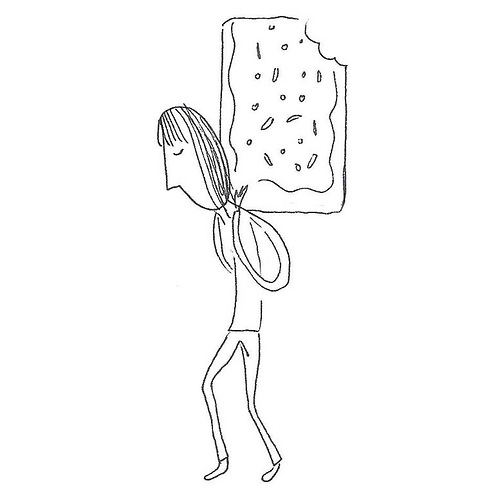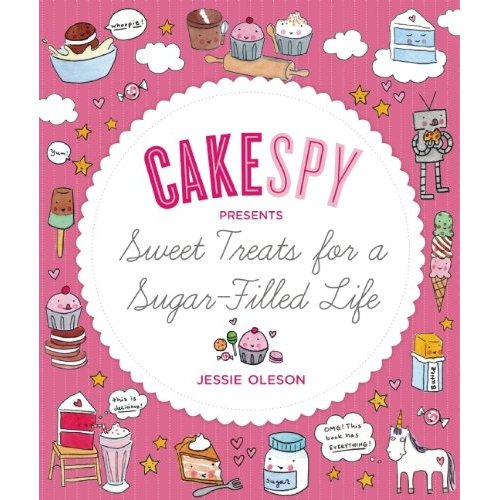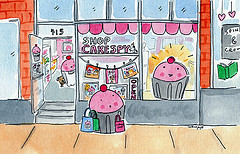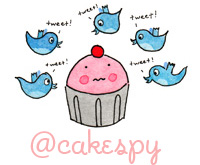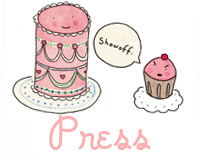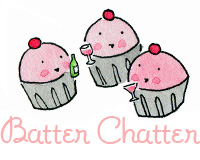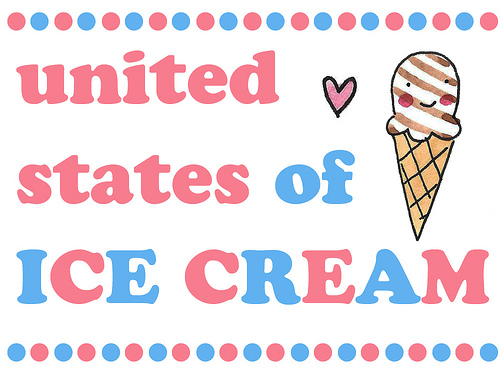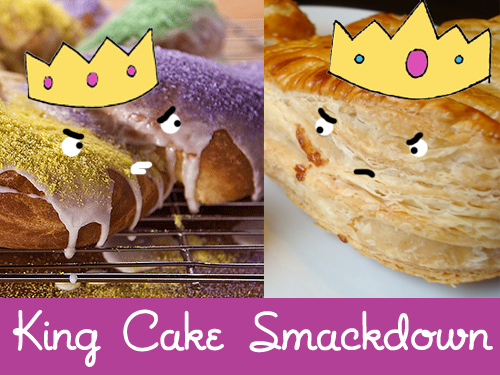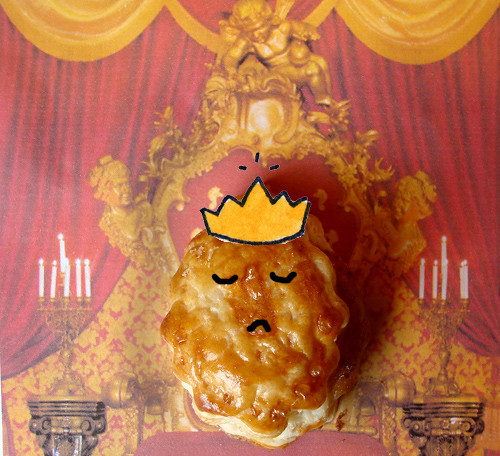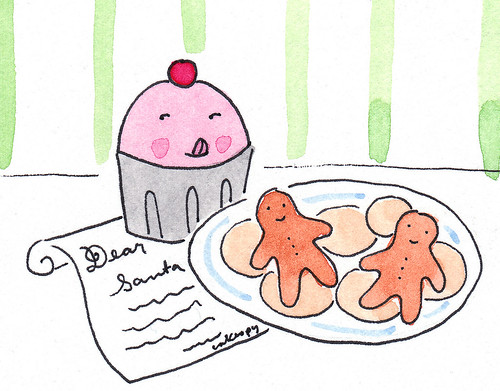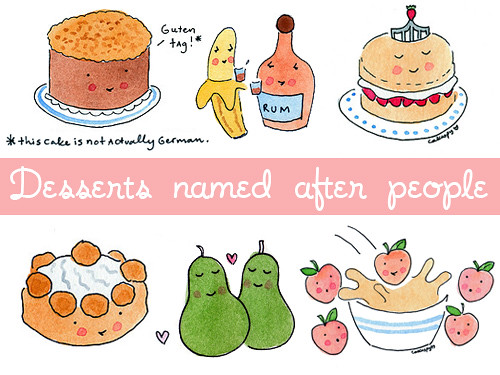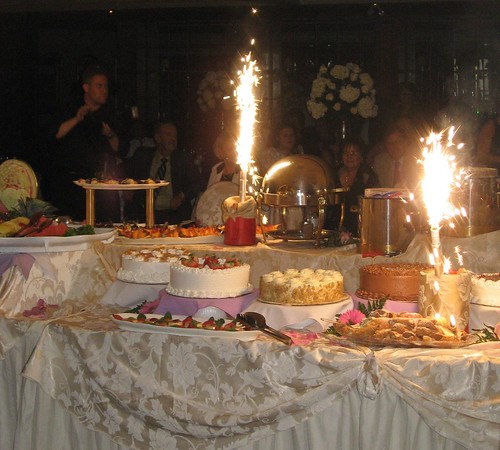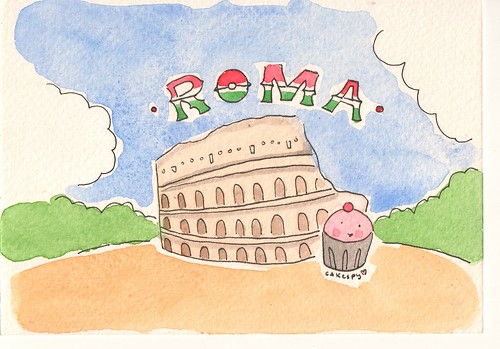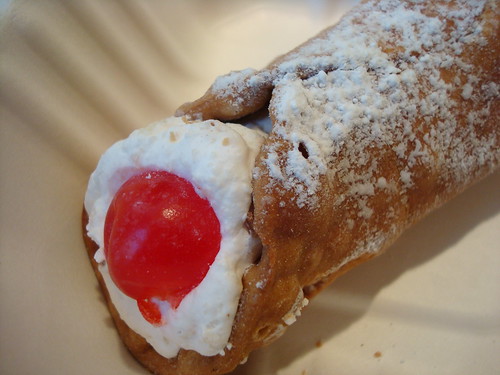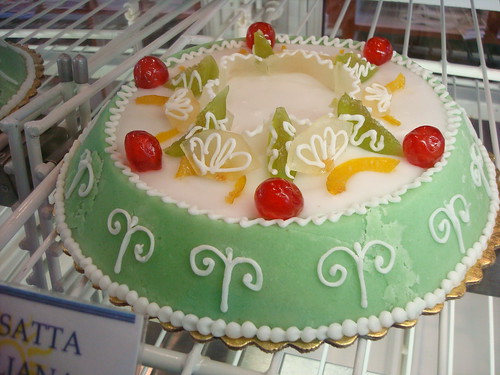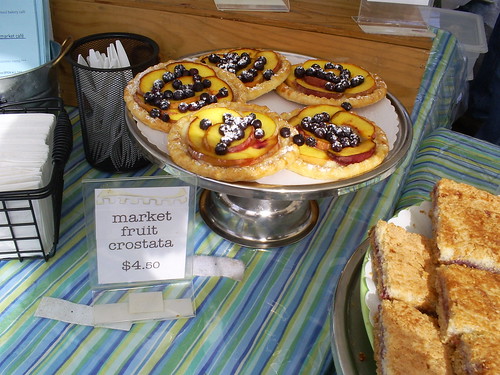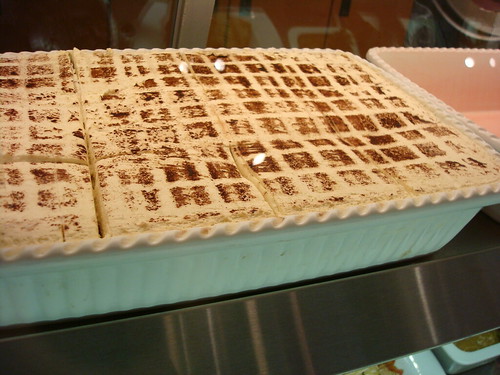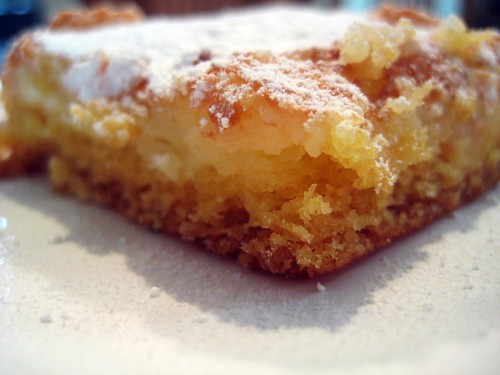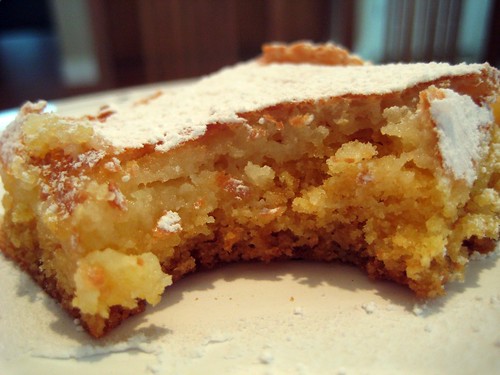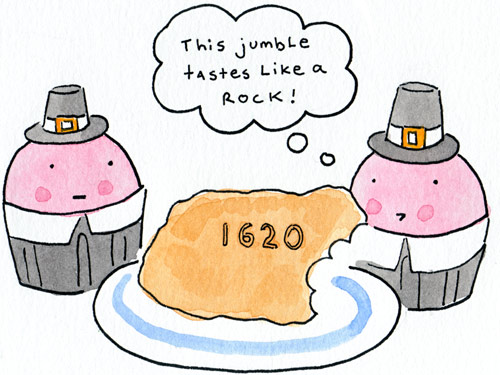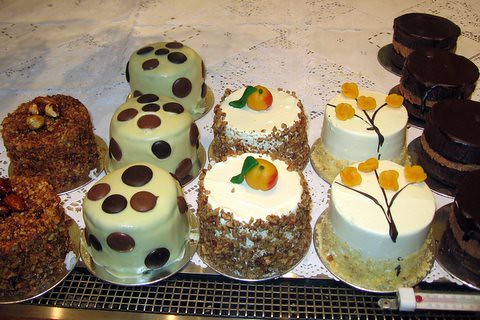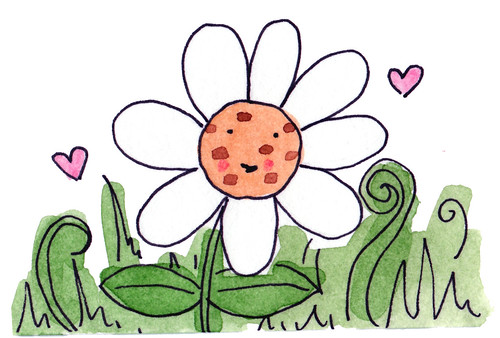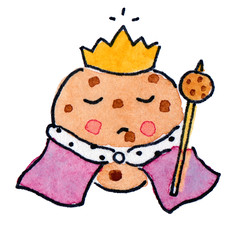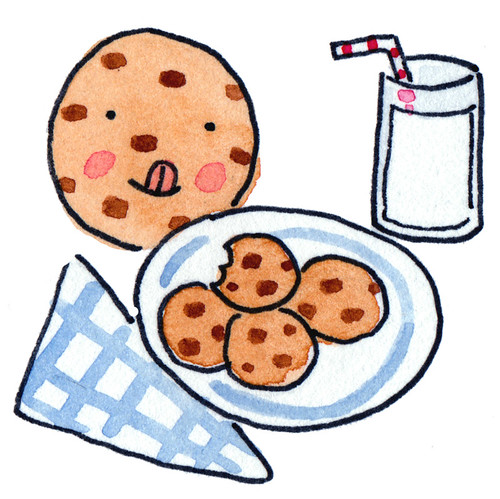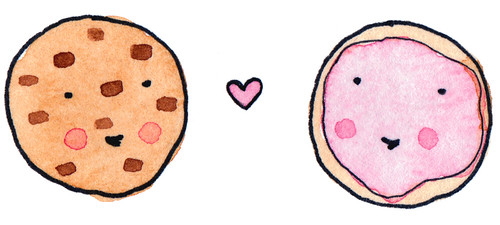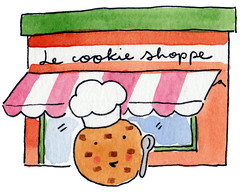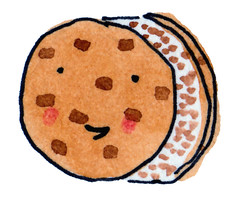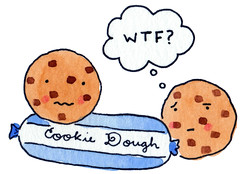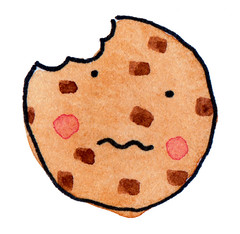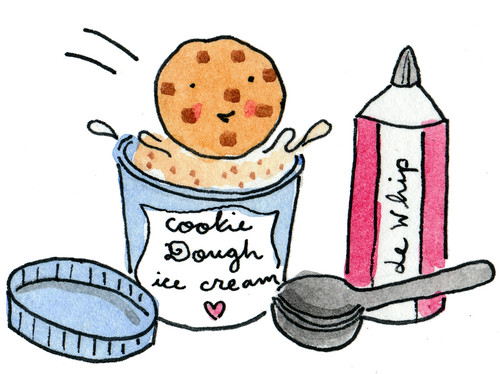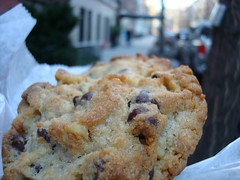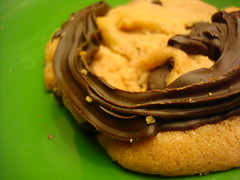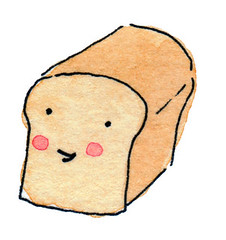
Anadama Bread: There are several legends behind this bread (including a family that claims ownership), so I'm going to go with my favorite one: "A fisherman, angry with his wife, Anna, for serving him nothing but cornmeal and molasses, one day adds flour and yeast to his porridge and eats the resultant bread, while cursing, 'Anna, damn her.' " Oh Anna, you may have been cursed, but the bread is so sweet, and delicious when liberally buttered. Here's a recipe from the wonderful Melissa Clark.
B
- - - - - - - - - - - - -
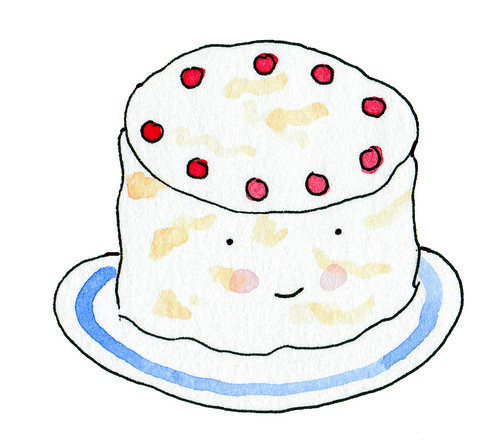
Lady Baltimore Cake: Per What's Cooking America, A Southern specialty that in the present day has many recipe variations. A favorite wedding cake, this mountainous cake is a white cake topped with a boiled or "Seven Minute Frosting." What makes the cake so distinctive is the combination of chopped nuts and dried or candied fruits in its frosting. It takes its name from the main character in Owen Wister's Lady Baltimore . For more lore and a vintage recipe, visit The Old Foodie.
. For more lore and a vintage recipe, visit The Old Foodie.
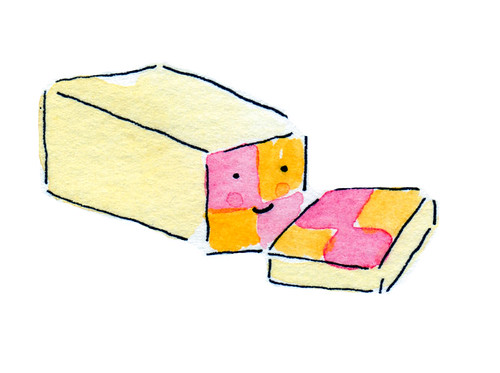
Battenberg cake (also called window cake): Per Wikipedia: This is a sponge cake which, when cut in cross section, displays a distinctive two-by-two check pattern alternately colored pink and yellow. The cake is covered in marzipan and, when sliced, the characteristic checks are exposed to view. These coloured sections are made by dying half of the cake mixture pink, and half yellow, then cutting each resultant sponge into two long, uniform cuboids, and joining them together with apricot jam, to form one cake. Though the origins of the name are not clear, it is rumored that the cake was created in honor of the 1884 marriage of Queen Victoria's grand-daughter to Prince Battenburg, with each of the four squares representing each of the four Battenburg Princes: Louis, Alexander, Henry and Francis Joseph. Here's a recipe.
Sarah Bernhardt Cakes: This sweet seems to waver between cookie and cake, but generally consists of a rich, nutty filling enrobed in chocolate. Either way, they take their name from famous French actress Sarah Bernhardt (1844–1923). Here's a recipe.
Betty: A Betty (or frequently, Apple Brown Betty) is a dessert which consists of a baked pudding made with layers of sweetened and spiced fruit (commonly apples) and buttered bread crumbs. It is usually served with a lemon sauce or whipped cream. The thing I can't tell you is who Betty is (do you know?); however, I can share a recipe I found.
Bismarck: Is the filled doughnut named for Otto Von Bismarck? Some say yes, some say no, but I like the explanation on Joe Pastry:
Some claim Bismarcks are called Bismarcks because Otto von Bismarck was fond of them. There's really no proof of this, since the only thing Bismarck was actually known to have an appetite for were small Northern European nation states. My guess is that the Bismarck got its name not because the Iron Chancellor loved to eat them, but because, being fairly plump pieces of pastry, they rather resembled him (he was not a thin man). But who really knows?
Either way,
here's a recipe.C
- - - - - - - - - - - - -
Charlotte Corday: This ice cream dessert, dreamed up by Charles Ranhofer of Delmonico's, is named after Charlotte Corday (1768–1793), the assassin of the radical Jean-Paul Marat. The directions, from Ranhofer's The Epicurean Part Two are as follows:
are as follows:
Obtain some round crimped paper cases; cover the bottoms and sides with uncooked Andalusian ice cream and fill the centers with biscuit glacé preparation with vanilla, adding a little maraschino to it; also put in some candied orange peel cut in exceedingly thin fillets; powder the tops with pulverized macaroons and cover this with Andalusian ice cream and candied fruits. Lay them in a freezing box for an hour to finish freezing.
Apple Charlotte: Per What's Cooking America, This is a golden-crusted dessert made by baking a thick apple compote in a mold lined with buttered bread. This dessert was originally created as a way to use leftover or stale bread. Some historians think that this sweet dish took its name from Queen Charlotte, known as being a supporter of apple growers.

Charlotte Russe: A cold dessert of Bavarian cream set in a mold lined with ladyfingers; it was invented by the French chef Marie Antoine Carême (1784–1833), who either named it in honor of his Russian employer Czar Alexander I ("Russe" being the French equivalent of the adjective, "Russian") or Queen Charlotte (1744–1818), wife of George III.
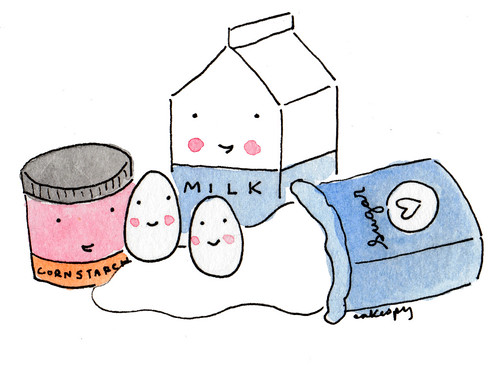
Chiboust cream: This heavenly substantce is a crème pâtissière (pastry cream) lightened with whipped cream or stiffly beaten egg whites. It is eponymously titled for the French pastry chef Chiboust who invented it in the 1840s, intending to use it to fill his Gâteau Saint-Honoré. The filling is also sometimes called Saint-Honoré cream, and I have also seen cream filled pastries called simply Chiboust. Check out this recipe which includes vanilla chiboust (along with caramelized bananas and doughnuts? Booyea!).
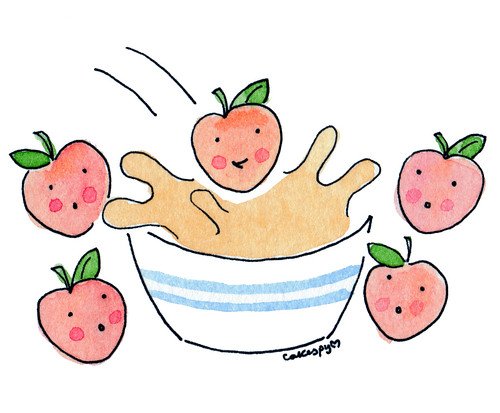
Peach pudding à la Cleveland: Another dish by Charles Ranhofer, named for Grover Cleveland (1837–1908), 22nd and 24th U.S. president--although Cleveland was reputed to not much like French food.
D
- - - - - - - - - - - - -

Little Debbie Cakes: Oh, to have an entire line of snack cakes named after you! Such is the case of the Little Debbie Brand--the story goes as follows (via the Little Debbie website):
In 1960, McKee Foods founder O.D. McKee was trying to come up with a catchy name for their new family-pack cartons of snack cakes. Packaging supplier Bob Mosher suggested using a family member's name. Thinking of what could be a good fit for the brand, O.D. arrived at the name of his 4-year-old granddaughter Debbie. Inspired by a photo of Debbie in play clothes and her favorite straw hat, he decided to use the name Little Debbie® and the image of her on the logo. Not until the first cartons were being printed did Debbie's parents, Ellsworth and Sharon McKee, discover that their daughter was the namesake of the new brand.
Oh, and if you want more Little Debbie fun,
check this out.Desdemona: Per The International Dictionary of Desserts, Pastries, and Confections: A Comprehensive Guide This is a pastry composed of two 3-inch round biscuits sandwiched together with vanilla whipped cream, brushed with apricot glaze, and covered in a kirsch-flavored fondant; it is named after the wife of Othello in the Shakespeare play. I only wish I had a recipe!
This is a pastry composed of two 3-inch round biscuits sandwiched together with vanilla whipped cream, brushed with apricot glaze, and covered in a kirsch-flavored fondant; it is named after the wife of Othello in the Shakespeare play. I only wish I had a recipe!
Dione's Chocolate Roll: This very chocolatey jellyroll style cake was the single dessert served at onetime NYC eatery The Egg Basket, and was named for proprietress Dionne Lucas. A recipe can be found in Maida Heatter's Great Desserts, and a variation can be found here.
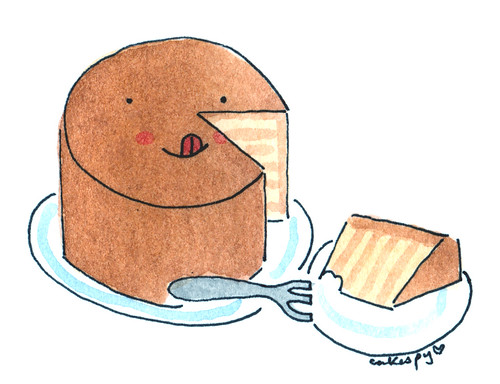
Doboschtorte or Dobostorta: Per Wikipedia, It is a five-layer sponge cake, layered with chocolate buttercream and topped with thin caramel slices. The sides of the cake are sometimes coated with ground hazelnuts, chestnuts, walnuts or almonds but the original cake is without coat, since it was a slice of a big cake. It is named for its creator, Hungarian pastry chef Josef Dobos. Just look at this recipe.
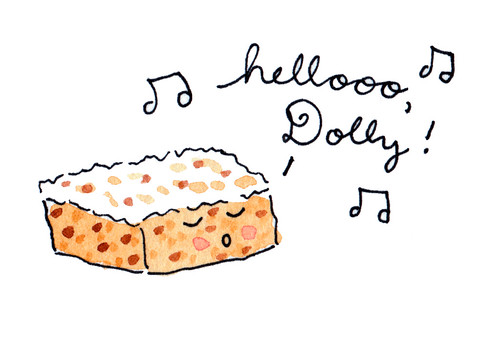
Hello Dolly Bars: I'll be honest. I don't know the story behind the name of these bars, which also go by "Seven Layer Bars"--but I love the taste enough to include them in this roundup. Here's a recipe.
Lorna Doone: This packaged shortbread cookie made by Nabisco takes its name from the character of the same name in the novel Lorna Doone: A Romance of Exmoor (read more here). Want to try to make your own at home? Try this recipe.
E
- - - - - - - - - - - - -
Mamie Eisenhower fudge: This rich, creamy fudge (which is also called "Million Dollar Fudge") takes its name from the first lady and the wife of U.S. President Dwight D. Eisenhower, Mamie D. Eisenhower. It was her contribution to a 1950's collection of recipes published by Women's National Press Club of Washington, D.C. Here's the recipe as it appeared in that book.
Elvis: I am going to go ahead and say that the banana, peanut butter and fluff combination is associated enough with Elvis to make the list. Uses for the flavor combination range from his favorite sandwich to pies and cakes. Here's just one wonderful recipe.
Essie's Cookies: This recipe, which I found in Betty Crocker's Cooky Book
, is a simple rolled cookie with almond extract; as to who Essie is, I haven't the faintest, but here's a recipe.
F
- - - - - - - - - - - - -
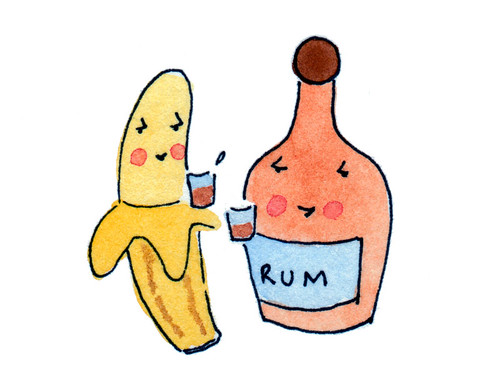
Bananas Foster: This dish which beautifully melds bananas, booze, and fire, is named after Richard Foster, regular customer and friend of New Orleans restaurant Brennan's owner, which is where the dish originated. Here's the Brennan's recipe!
Frangipane: This is an almond pastry filling and tart, named for Marquis Muzio Frangipani, a 16th-century Italian of the Frangipane family (also known as Cesar Frangipani) living in Paris. He also invented a well-known bitter-almond scented glove perfume, used by Louis XIII. As for a recipe? How 'bout an apricot, cherry, and frangipane tart?
Joe Frogger: These molasses-rich cookies take their name from "Black Joe", whose partner, Lucretia Brown, invented the recipe.Find a recipe and more lore here.
G
- - - - - - - - - - - - -
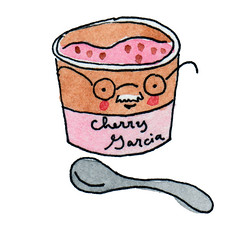
Cherry Garcia ice cream: This is a cherry and chocolate flake-flecked ice cream homage to Jerry Garcia of the Grateful Dead by Ben & Jerry. And, there's actually a recipe to make it yourself at home!
Garibaldi biscuits: These raisin or currant-filled English biscuits were named for Giuseppe Garibaldi (1807–1882), an Italian patriot and leader of the drive to unite Italy, after his wildly popular visit to England in 1864. (Per Wikipedia, There is also a French demi-glâce sauce with mustard and anchovies, and a consommé named after him.)
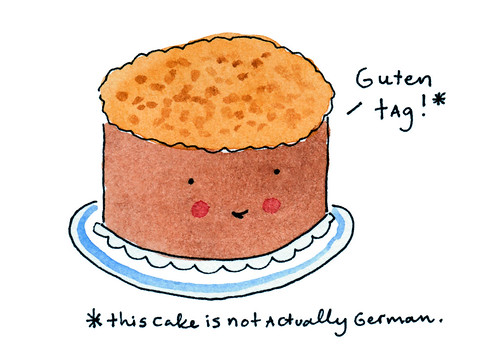
German chocolate cake: It's named after a good German, but he wasn't actually German. This chocolate and coconut throwback to the 1950's to Sam German, who developed Baker's German's Sweet Chocolate (which falls somewhere between milk and semi-sweet) in 1852. Here's a recipe.
Gianduja: Per Wikipedia, this is a sweet chocolate containing about 30% hazelnut paste, invented in Turin by Caffarel and Prochet in 1852. It takes its name from Gianduja, a Carnival and marionette character who represents the archetypal Piedmontese, the Italian region where hazelnut confectionery is common. Here's a recipe from Dana Treat for gianduja mousse!
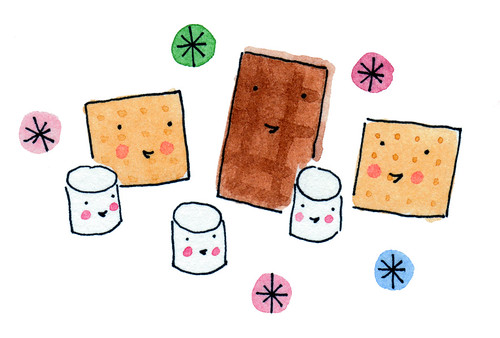
Graham crackers: These s'more-mobiles take their name from Graham flour, which in turn takes its name from Sylvester Graham, 19th-century American Presbyterian minister and proponent of a puritan lifestyle based on teetotalling, vegetarianism, and whole wheat, who probably twists uncomfortably in his grave every time a deliciously chocolatey, marshmallowy s'more is devoured. Remember when CakeSpy introduced the world to S'moreos?
Bombe Grimaldi: Per Wikipedia, this kümmel-flavored frozen dessert probably named for a late-19th-century member or relative of Monaco's royal Grimaldi family. There is also an apple flan Grimaldi. However, I don't think either of these are related to the pizza.
Gundel Palacsinta: This is a crêpe-like pancake stuffed with rum-infused raisins and nuts and served with a chocolate-rum sauce, named for (and invented by) Hungarian chef Gundel Károly. Recipe? This one sounds good to me.
Gypsy Bar: Apparently there was a candy bar named after Gypsy Rose Lee (you know, the one that the musical was based on!). What flavor is it? Sorry friends, I am not sure.
H
- - - - - - - - - - - - -
Hamantash (or Hamantashen): A small pastry allegedly named for the hat of the cruel Persian official outwitted by Queen Esther and hanged, Haman, in the Book of Esther. Hamentashen are traditionally eaten at Purim. You can read more here and find a recipe here!
Heath bar: This American "English toffee" bar is named for brothers Bayard and Everett Heath, Illinois confectioners who developed it in the 1920s and eventually turned the local favorite into a nationally popular candy bar. Here's a homemade Heath Bar recipe!
Oh Henry!: This candy bar, introduced by the Williamson Candy Company in Chicago, 1920, was named for a young man who frequented the company store and was often called (or perhaps admonished?) with said phrase.
Hernani Biscuit: Another Charles Ranhofer special, comprised of a Savoy biscuit with marmalade, fondant, chocolate and pastilles; possibly named for the rascal in Victor Hugo's play.
Hershey Bar: To say that Hershey is "just a chocolate bar" would be a vast understatement. It's a company, a product...and a town! And it is all named for the guy who started it all, Milton S. Hershey, who developed the bar in 1900. Read more here.
Hiroko: This raspberry Grand Marnier cream cake tart (cake and tart! at once!) takes its name from pastry chef Hiroko Ogawa; a recipe can be found in Rose Levy Beranbaum's The Pie and Pastry Bible .
.
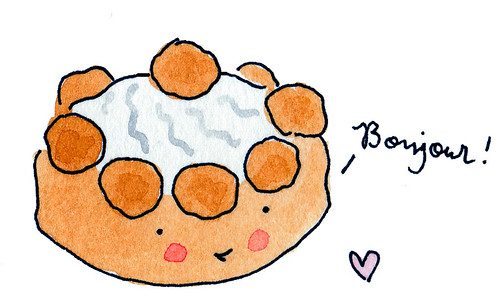
Gâteau Saint-Honoré: Per Wikipedia,
this dessert is a circle of puff pastry at its base with a ring of pâte à choux piped on the outer edge. After the base is baked small cream puffs are dipped in caramelized sugar and attached side by side on top of the circle of the pâte à choux. This base is traditionally filled with crème chiboust and finished with whipped cream using a special St. Honore piping tip. The pastry is named for the French patron saint of bakers, confectioners, and pastry chefs, Saint Honoré or Honorius (d. 653), Bishop of Amiens. The pastry chef Chiboust (see Chiboust cream) is thought to have invented it in his Paris shop in 1846.
Houdini Bar: I am not sure about the origins of this delicious cream cheese, yellow cake, nut and coconut bar cookie, but I discovered it fairly recently; it is said to be named because the bars are so delicious they disappear as quickly as the famous magician. Here's the recipe.
Humboldt pudding: Another Ranhofer special, an elaborate molded pudding named after Alexander von Humboldt (1769–1859), the famous explorer and influential naturalist.
I
- - - - - - - - - - - - -
Iago: Per The International Dictionary of Desserts, Pastries, and Confections: A Comprehensive Guide these pastries are composed of two 2-inch round biscuits sandwiched together with coffee-flavored pastry cream, brushed with apricot glaze, and covered in coffee-flavored and colored fondant. They take their name from the villain in Shakespeare's Othello.
these pastries are composed of two 2-inch round biscuits sandwiched together with coffee-flavored pastry cream, brushed with apricot glaze, and covered in coffee-flavored and colored fondant. They take their name from the villain in Shakespeare's Othello.
It Bar: The connection is perhaps indirect, but this candy bar of yesteryear took its name after "It" girl Clara Bow.
J
- - - - - - - - - - - - -
Cousin Jack Cookies: This name is more symbolic, a "Cousin Jack" being a catchall term to describe the working-class miner immigrants from Cornish who settled in the midwest--but these drop cookies with currants are worth noting. Here's a recipe.
Apricots with rice à la Jefferson: Another Ranhofer delight! At the time of its invention, Ranhofer used a recently developed strain of Texas rice. It was aptly named, as apparently (per Wikipedia) Jefferson was very interested in improving American rice culture.
Johnnycake: These corn cakes were not sweet, but they were some of the earliest pancakes in the USA! However, to do some myth-busting, they aren't actually named for a guy named Johnny. Per What's Cooking America,
The origin of the name johnnycakes (jonnycakes) is something of a mystery and probably has nothing to do with the name John. They were also called journey cakes because they could be carried on long trips in saddlebags and baked along the way. Some historians think that they were originally called Shawnee cakes and that the colonists slurred the words, pronouncing it as johnnycakes. Historians also think that "janiken," an American Indian word meant "corn cake," could possibly be the origin.
K
- - - - - - - - - - - - -
Kaiserschmarrn: Per Wikipedia, this is a light, caramelized pancake made from a sweet batter with flour, eggs, sugar, salt and milk, baked in butter. But even better than the delicious treat is the story behind it:
It is generally agreed that the dish was first prepared for the Austrian Emperor Francis Joseph I (1830–1916). There are several stories. One apocryphal story involves the Emperor and his wife, Elisabeth of Bavaria, of the House of Wittelsbach. Obsessed with maintaining a minimal waistline, the Empress Elisabeth directed the royal chef to prepare only light desserts for her, much to the consternation and annoyance of her notoriously austere husband. Upon being presented with the chef’s confection, she found it too rich and refused to eat it. The exasperated Francis Joseph quipped, “Now let me see what "Schmarrn" our chef has cooked up”. It apparently met his approval as he finished his and even his wife’s serving. Thereafter, the dessert was called Kaiserschmarrn across the Empire.
Here's a recipe.L
- - - - - - - - - - - - -
Lafayette Gingerbread: Per Saveur, according to tradition, this gingerbread was named after General Lafayette in the 1780s after George Washington's mother served him a piece, captivating him forever. Saveur also has a recipe.
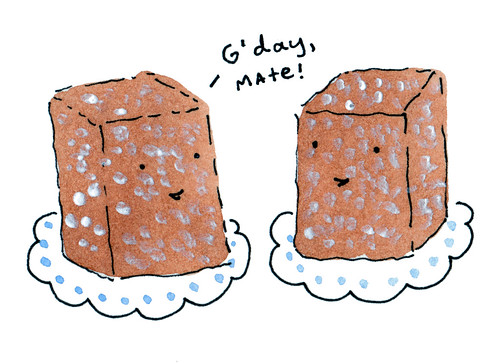
Lamingtons: Per Joy of Baking, Lamingtons are very popular in Australia and consist of a small square of white cake (sponge, butter, or pound) that is dipped in a sweet chocolate icing and then rolled in desiccated coconut. I suspect Lord Lamington (Governor of Queensland from 1896 - 190l), their namesake, might be surprised at how popular these cakes have become. Joy of Baking also features a recipe.
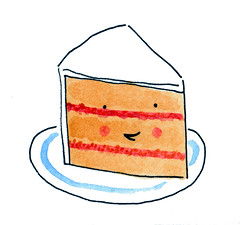
Lane Cake: Per this site, Lane Cake is a quintessential Southern dessert, with a signature filling of a rich coconut and raisin mix. It has been around at least since the late 1800s, when Emma Rylander Lane, of Clayton, Alabama, won first prize with it at the Alabama State Fair. The Lane cake appeared in her cookbook in 1898, when it was called “Prize Cake.” Here's a recipe.
Leibniz-Keks: This German butter biscuit (similar to petit beurre biscuits) is named for philosopher and mathematician Leibniz, although as Wikipedia informs, ". The only connection between man and biscuit is that Leibniz was one of the more famous residents of Hanover, where the Bahlsen company is based."
Lindy Candy Bar: This candy bar was named for Charles Lindbergh, the famous pilot who was first to fly solo, non-stop, across the Atlantic Ocean. He also had another bar named after him: the "Winning Lindy."
Sally Lunn: Sweet, yeast-risen buns which are considered a British classic. They are traditionally served warm, split in half and spread generously with butter or cream. So who is Sally? Well, some claim that the chef who invented them in Bath, England was named Sally Lunn. Others claim that the name actually comes from the phrase "sol et lune", a French cake. Yet others claim that it is derived from the Alsatian bread solilmeme, a rich type of brioche. Whatever the true story is though, bet you'll enjoy this recipe (which can be translated).
Lussekatter (or, St. Lucia buns): These yeast-and-saffron buns are named for Saint Lucia of Syracuse (283–304), whose name day on December 13 was once considered the longest night of the year. Lucia means "light", and these buns certainly are a ray of shining sweetness on a cold, dark night. Here's a recipe.
M
- - - - - - - - - - - - -
Madeleine: These tres-Frenchie sponge cake cookies are best known for their shape (usually a scalloped shell) and for their famous writeup in Proust's Remembrance of Things Past. Alas, which Madeleine inspired the name is a bit less clear. Per Wikipedia, some sources, including the New Oxford American Dictionary, say madeleines may have been named for a 19th century pastry cook, Madeleine Paulmier, but other sources have it that Madeleine Paulmier was a cook in the 18th century for Stanisław Leszczyński, whose son-in-law, Louis XV of France, named them for her. The Larousse Gastronomique offers two conflicting versions of the Madeleine's history. Want a recipe? How about Orange and Brown Butter madeleines, via Cannelle et Vanille?
Bain-Marie: This isn't a food, but it's a term often seen in sweet recipes: a bain-marie is a double boiler; it was initially developed for the practice of alchemy, but pretty early on it became evident that it's a great asset to baking too. But who is the Marie to whom the name can be attributed? According to Wikipedia, there are a few theories:
- According to culinary writer Giuliano Bugialli, the term comes from the Italian bagno maria, named after Maria de'Cleofa, who developed the technique in Florence in the sixteenth century.
- Alternatively, the device's invention has been popularly attributed to Mary the Jewess, an ancient alchemist traditionally supposed to have been Miriam, a sister of Moses.[citation needed] The name comes from the medieval-Latin term balneum (or balineum) Mariae—literally, Mary's bath—from which the French bain de Marie, or bain-marie, is derived.
- According to The Jewish Alchemists, Maria the Jewess was an ancient alchemist who lived in Alexandria—although this would seem to contradict the tradition that she was Moses' sister: Alexandria was founded by Alexander the Great in 334 BC, while Moses is thought to have lived around 1450-1200 BC.
Martha Washington's Cake: Also called the "Great Cake"--a behemoth which called for 40 eggs, 5 pounds of fruit, and so on, it's named for (duh) the first First Lady of the US, Martha Washington.
Poires Mary Garden: This dessert dish was created by Escoffier (who also created Peach Melba and several other dishes in honor of various famous ladies) for Mary Garden (1874–1967), a popular opera singer in Europe and the U.S. at the turn of the century.
Mary Jane: This peanut butter and molasses candy bar (alas, the one we never ate from our trick or treating bounty) was developed by Charles N. Miller in 1914; it's named after his favorite aunt.
Mars Bar: Think this chocolate bar is cosmically good? Well, you're right, but the name's inspiration isn't planetary: it comes from Frank C. Mars, whose mother taught him how to make candy at an early age and ultimately started the Mars candy company.
Massillon: This is a small French almond pastry is named for Jean-Baptiste Massillon (1663–1742), a famous preacher of his day who was, for a time, favored by Louis XIV (they later had their differences). The pastry originated in the town of Hyères, where Massillon was born, proud of their hometown hero. Alas, I was not able to easily find a recipe!
Peach Melba: A post-dinner dish of peaches and raspberry sauce accompanying vanilla ice cream. This sweet treat was invented by famous chef Chef Auguste Escoffier at the Savoy Hotel in the 1890s, after he heard the famous singer Nellie Melba performing at Covent Garden. Should you prefer sweet treats to sweet music, here's a recipe.
Mozart: Per Manna Cafe, "The composer Wolfgang Amadeus Mozart (1756–1791) scored this ball of pistachio and almond marzipan with an outer layer of nougat coated with bitter chocolate in 1890 in Salzburg. Eat your heart out, Salieri!"
N
- - - - - - - - - - - - -
Nadege Tart: This lemon curd tart is unique in that it is devoid of starch; it is named for Nadege Brossllet and a recipe can be found in Rose Levy Beranbaum's The Pie and Pastry Bible
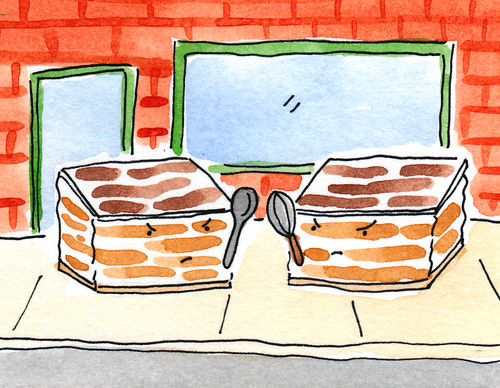
Napoleon: Though few will argue that this treat, composed of cream and flaky pastry layers all topped with a decorative fondant icing, is extremely tasty, there is some argument over the name. Some say that this pastry it is named for the emperor; however, what is more likely is that it is actually named for the city Naples. To that point--in France, they don't even call them Napoleons, they call them mille-feuille.Here's a recipe.
Nesselrode Pudding (and Nesselrode Pie): This chestnut-rich (sometimes secretly supplemented with cauliflower!) confection takes its name from Russian diplomat Count Karl Robert von Nesselrode (1780–1862). As a pie, Nesselrode enjoyed a vogue in the New York area in the 1950s, but has all but disappeared. Read about my relentless search for the pie here.
Marshal Ney: Per Wikipedia, This is an elaborate Ranhofer dessert, comprised of molded tiers of meringue shells, vanilla custard, and marzipan, is named after Napoleon's Marshal Michel Ney (1769–1815), who led the retreat from Moscow and was a commander at Waterloo.
O
- - - - - - - - - - - - -
Bath Oliver biscuits: These digestive biscuits (I know! How appealing!) were dreamed up by Dr. William Oliver (1695–1764) of Bath, England--two guesses as to where the name comes from. These biscuits aren't actually very sweet, but I really wanted something to bulk up (get it?) the "O" section of this list.
Othello: Per The International Dictionary of Desserts, Pastries, and Confections: A Comprehensive Guide , this pastry is composed of two three-inch round biscuits, similar to ladyfingers, sandwiched together with chocolate pastry cream, brushed with apricot glaze, and completely covered with chocolate fondant.
, this pastry is composed of two three-inch round biscuits, similar to ladyfingers, sandwiched together with chocolate pastry cream, brushed with apricot glaze, and completely covered with chocolate fondant.
P
- - - - - - - - - - - - -
Pastilles: These flavored candylike tablets were named for and invented by Giovanni Pastilla, Italian confectioner to Marie de Medici.
Pâte à Panterelli: This early version of what would become Choux pastry is named for Panterelli, a chef for Catherine de Medici who was brought to France from Italy. He had a dough recipe which became known as Pâte à Panterelli. This is the dough that was altered and perfected to become what we now know as choux pastry--and anyone who has ever had a cream puff knows what an important service Panterelli provided to all of mankind.
Pavlova: This lovely and light fruit and meringue dessert is named after the famous Russian ballerina Anna Pavlova (1881–1931), famous Russian ballerina; both Australia and New Zealand have claimed to be the places of invention, though it looks good for Australia in my opinion, as it is their national cake and all. One thing is for sure though: the ballerina only shared a "light as air" similarity with the dessert; I've heard it is unlikely she ever partook. Here's a recipe.
Praline: To clarify: we're talking about the French type of praline here, which is a caramelized almond confection-- Per Wikipedia, it takes its name from César de Choiseul, Count du Plessis-Praslin (1598–1675), by his officer of the table Lassagne, presented at the court of Louis XIII. The caramelized almond confection was transformed at some point in Louisiana to a pecan-based one (probably because of availablility?). Though it's not the authentic French version, Paula Deen's Pecan Praline recipe looks mighty good.
Toronchino Procope: Another Ranhofer confection! This ice cream dessert was named after the Sicilian Francesco Procopio dei Coltelli, whose Café Procope, which opened in Paris in 1686, is cited as the first flavored ice joint in the City of Lights!
Q
- - - - - - - - - - - - -
Queen Elizabeth Cake (Canada): What's the story behind this rich date-based cake? According to Practically Edible,
Apparently the recipe might have been sold, for 15 cents a copy, as a fund-raiser during the Second World War, and as Queen Elizabeth, the Queen Mother, was very popular in Canada and rallied people during the war, it may have been named in her honour there. It definitely appeared in war-time cookbooks during the 1940s. It re-appeared in Canadian cookbooks in 1953, for the coronation of Queen Elizabeth II, and since then, due to its ease, has been a staple at country fairs since then. It is also known in the UK and in the States, though it's not as ubiquitous there as it is in Canada.
Practically Edible also has a recipe.Queen Elizabeth Cake (USA): This is a fruit-and-whipped cream cake which was made in the 1950's by Chicago area bakery
Deerfield's in honor of a Chicago visit by Queen Elizabeth; it's still one of their popular cakes. It seems to be unrelated to the Queen Mother's cake in flavor, it is nonetheless named for the same queen.
Queen Mother's Cake: A flourless chocolate cake which, according to Wikipedia, was served to Queen Elizabeth (Queen Mother) in the 1950s by her friend Jan Smeterlin (1892–1967), well-known Polish pianist. Smeterlin had acquired the recipe in Austria, and the Queen Mother's fondness for the cake produced its name, via either Smeterlin, food writer Clementine Paddleford or dessert maven Maida Heatter.
R
- - - - - - - - - - - - -
Sally Rand: Another candy bar named for a stripper! You won't find it anymore, but it took its name from the (in)famous Sally Rand.
Reggie Bar: Another now-extinct candy bar, this one was named for Reggie Jackson, the American baseball icon.

Rigó Jancsi: Per Wikipedia, this Viennese cube-shaped chocolate sponge cake and cream pastry is named after the famous Gypsy violinist, Rigó Jancsi (by Hungarian use, Rigó is his last name, Jancsi his first, called literally 'Blackbird Johnny'). Here's a recipe!
Robert E. Lee Cake: This lemon layer cake hails from the American south and is named for American Civil War General Robert E. Lee (1807–1870). Here's a recipe (and here's more of the story)!
Robert Redford Cake: Also called "Better than Robert Redford Cake" or "Better than Sex Cake", I've never quite understood the appeal of this cream cheese n' pudding layered confection, but to each his (or her) own. Here's a recipe.
Strawberries Romanoff: I love the story I found on Epicurious:
When he was the chef at the Carlton Hotel in London, Escoffier created Strawberries Americaine Style — strawberries in orange liqueur, blended into whipped cream and softened ice cream. Little did he know that it would one day be the star dessert of every posh dining spot in California. "Prince" Mike Romanoff "borrowed" the recipe and gave it a new moniker. Soon it was the hottest item on the West Coast. The L.A. Biltmore called it "Strawberries Biltmore." The Palace Hotel in San Francisco served it with anisette and maraschino.
Incidentally, Epicurious
also has a recipe.Rosalinda: Per The International Dictionary of Desserts, Pastries, and Confections: A Comprehensive Guide , this pastry is comprised of
, this pastry is comprised of
two three-inch round biscuits, similar to ladyfingers, sandwiched together with rosewater or kirsch-scented whipped cream, brushed with apricot glaze, and covered in pink rosewater or kirsch-flavored fondant.
This pastry takes its name from the character Rosalind in Shakespeare's
As You Like It.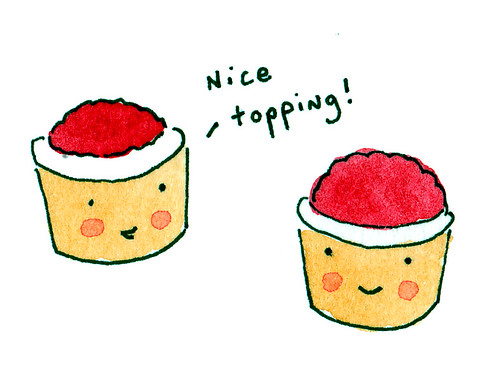
Runeberg Cake (Also Runebergintorttu / Runebergstårta): This is a cake comprised of a dry almond cake infused with a splash of rum and topped with a ring of icing and a healthy dollop of jam. It was made in honor of the Finnish poet Johan Ludvig Runeberg (1804–1877) by his wife, Fredrika. It's frequently served on February 5th (Runeberg Day, natch!). There is also a variation of this called the Fredrika-pastry. Here's a goodlookin' recipe.
Baby Ruth candy bar: Who is the real Baby Ruth that this chocolate covered caramel-and-nut confection? Per this site there are three theories:
- The bar was named after "Baby" Ruth Cleveland, the first-born daughter of President Groveland Cleveland.
- The bar was named after baseball slugger George Herman "Babe" Ruth.
- The bar was named for a granddaughter of Mrs. George Williamson, Mrs. Williamson being the wife of the president of the Williamson Candy Company and one of the developers of the "Baby Ruth" bar formula. Explanation #1 is the "official" explanation that has been proffered by the Curtiss Candy Company since the 1920's.
Which do you believe? Better grab a Baby Ruth bar while you mull it over, or better yet, why not try out this
Baby Ruth Layer Cake?Sonia Rykiel Chocolate Tart: This tart is described in Dorie Greenspan's Paris Sweets
as "filled with chocolate ganache and topped with a sunburst of sliced bananas, one of Sonia Rykiel's favorite fruits, and, with chocolate, one of the world's best flavor combinations"; it was created by chocolatier Christian Constant in honor of the chocolate-loving clothing designer. Here's an adaptation of the recipe with caramelized bananas.
S
- - - - - - - - - - - - -
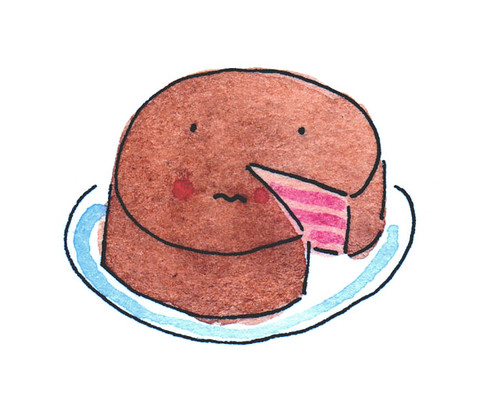
Sachertorte: Per What's Cooking America,
Sacher Torte is a famous Viennese cake, probably the most famous chocolate cake of all-time. It consists of chocolate sponge cake cut into three layers, between which apricot jam are thickly spread between the layers and on the top and sides of the cake. The whole cake is then iced with a velvet-like chocolate and served with a side dish of whipped cream.
It was created by pastry chef Franz Sacher (1816-1907) in 1832 for Prince Clemens Lothar Wensel Metternich (1773-1859) of Austria, the Austrian State Chancellor, and it is for him that it is named. However, that's not all there is to the story--
read about the drama of the Sachertorte here!Though this one isn't the traditional cake, I find these
Sacher Bites fascinating (and delicious-looking).
Sal-de-Dand Bar: Per Confectionarium, this was the first candy bar named after a stripper – Sally Rand, whose “fan dance” at the 1933-34 Chicago World’s Fair shocked and titillated the nation.
Salambô: Per The International Dictionary of Desserts, Pastries, and Confections: A Comprehensive Guide, this is an "individual round pastry made from a choux pastry puff and filled with kirsch-flavored pastry cream; the top is dipped in hat caramel or iced with gren fondant and sprinkled with shaved chocolate. It was named for the heroine in a novel which was also adapted into an opera."
this is an "individual round pastry made from a choux pastry puff and filled with kirsch-flavored pastry cream; the top is dipped in hat caramel or iced with gren fondant and sprinkled with shaved chocolate. It was named for the heroine in a novel which was also adapted into an opera."
Queen of Sheba cake: Or, if you're feeling authentic, the French Gâteau de la reine Saba, this is a chocolate cake which takes its name from the ancient African Queen of Sheba, famous guest of King Solomon of Israel. Check it: here's a recipe.
Simnel Cake: Per Wikipedia, this is
a light fruit cake, similar to a Christmas cake, covered in marzipan, and eaten during Lent or at Easter in Great Britain, Ireland and some other countries. A layer of marzipan or almond paste is also baked into the middle of the cake. On the top of the cake, around the edge, are eleven marzipan balls to represent the true disciples of Jesus; Judas is omitted.
and as it goes on to tell us,
A popular legend attributes the invention of the Simnel cake to Lambert Simnel, but this is clearly false since the Simnel cake appears in English literature prior to Lambert's escapades.
Here's a recipe.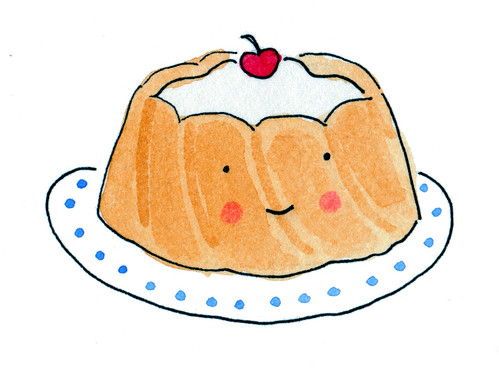
Savarin: This is a yeast-raised sweet cake soaked in Kirsch or rum; it is named for the legendary chef Brillat-Savarin. Here's an interesting recipe!
Schillerlocken: These cream-filled pastry rolls are said to have been inspired by the curly hair of German poet Friedrich von Schiller (1759–1805). Here's a recipe.
Crepes Suzette: This sweet and boozy crepe confection is undeniably delicious, but who the "Suzette" in question was is a bit of a mystery--as for my favorite story? According to The Old Foodie, "The favoured myth is that she was the mistress of Edward, Prince of Wales (the future Edward VII), although he vehemently denied knowing anyone by that name (surprise! surprise!)." Here's a recipe.
T
- - - - - - - - - - - - -
Talleyrand: This cherry-and-booze dish is named for epicurean French statesman Charles Maurice de Talleyrand-Périgord (1754–1838). An influential negotiator at the Congress of Vienna; Antonin Câreme worked for him for a time, and Talleyrand was instrumental in furthering his career; hence the bevy of dishes named after him. Here's a recipe.

Tarte Tatin: This upside-down tart can be made with a variety of different fillings; the style is sometimes called à la Demoiselles Tatin, after the two sisters who are said to have invented it, Stephine Tatin (1838–1917) and Caroline Tatin (1847–1911), who ran the Hotel Tatin in Lamotte Beuvron, France. As lore has it, Stephine allegedly invented the upside-down tart accidentally in the fall of 1898. The pastry in fact may be much older, but they gave it a name. Here's a recipe.
Shirley Temple: Per Wikipedia, A Shirley Temple (also known as a Grenadine Lemonade) is a non-alcoholic mixed drink made with ginger ale or Sprite or 7 Up and grenadine syrup garnished with maraschino cherries. The Royal Hawaiian Hotel at Waikīkī in Honolulu, Hawaii claims to have invented the Shirley Temple cocktail in the 1930s; it was named for the famous child actress Shirley Temple, who often visited the Royal Hawaiian Hotel. Here's a recipe.
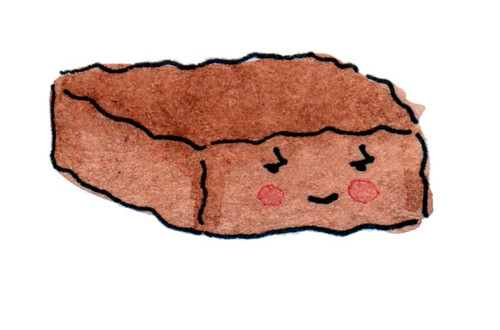
Alice B Toklas Brownies: The connection is legitimate, if tenuous. Her so-called "autobiography" had actually been largely written by Toklas' lifelong companion, Gertrude Stein, who died before its completion. According to this article, "With the deadline only a few months away, Toklas, then in her mid-70s, found herself half a book shy. So she began soliciting recipes from her artsy friends"--one of which was Brion Gysin's recipe for "Haschich Fudge". While the editors stateside removed the recipe, the British version didn't, and the media blitz began. An in a case of "you can't unring that bell", her name became associated with cannabis foods, most famously "Alice B. Toklas brownies" (or "Alice Toke-less" brownies) forever and ever amen.
Tootsie Rolls: To tell you the truth, I've never been exactly sure what Tootsie Rolls are, but they sure are sweet. They're named for Clara "Tootsie" Hirshfield, the small daughter of Leo Hirshfield, developer of the first paper-wrapped penny candy, in New York in 1896. Hey, if you have any leftover Tootsie Rolls from Halloween, why not try this recipe?
Tortoni or Biscuit Tortoni: This is a type of ice cream made with eggs and heavy cream, often containing chopped cherries or topped with minced almonds or crumbled macaroons. It is named for a gentleman named Tortoni, who is said to have invented the dish while working at the Parisian eatery Café Velloni. Later on he bought the place and renamed it the Café Tortoni. Here's a recipe.
Truman Pudding: Also called Bess Truman's Ozark Pudding, this fruit-and-nut pudding is served warm; it is said to have been one of Harry Truman's favorite recipes from wife Bess Truman's baking repertoire. Here's a recipe.
U
- - - - - - - - - - - - -
V
- - - - - - - - - - - - -
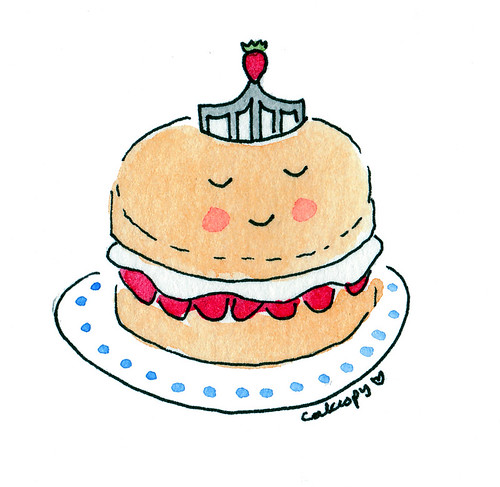
Victoria Sponge or Sandwich Cake: This cake, which combines light sponge cake with cream and fruit, is named for Queen Victoria (1819–1901). Apparently, according to Wikipedia, many other dishes are named for the British Queen, including sole, eggs, salad, a garnish, several sauces, a cherry spice cake, a bombe, small tarts, and more. Here's a Victoria Sponge Cake recipe.
W
- - - - - - - - - - - - -
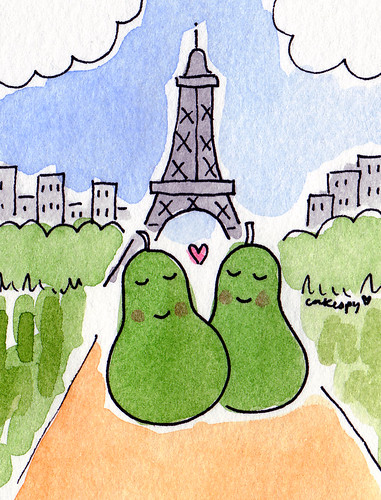
Pears Wanamaker (also called poires Wanamaker): The only reference I could find to this dish was in a 1971 issue of New York Magazine! It is said that the dish was likely named for the Philadelphia merchant family Wanamaker, particularly the son Rodman Wanamaker (1863–1928) seems most likely to be the inspiration for this dish; he went to Paris in 1889 to oversee the Paris branch of their department store. When he returned to the U.S. in 1899, he kept his Paris home and contacts (and pear recipes?).
Washington Pie: A cream pie which takes its name from George Washington--you know, that guy. Here's a recipe!
Wibele: These pastries are made of egg white, vanilla sugar, flour and confectioners' sugar and shaped like figure-eights; they are named after Jakob Christian Carl Wibel, who is said to have invented it in 1763 in Langenburg, Germany. If you happen to be in Germany, it looks like you could probably get some wibele here!
X
- - - - - - - - - - - - -
Y
- - - - - - - - - - - - -
Z
- - - - - - - - - - - - -
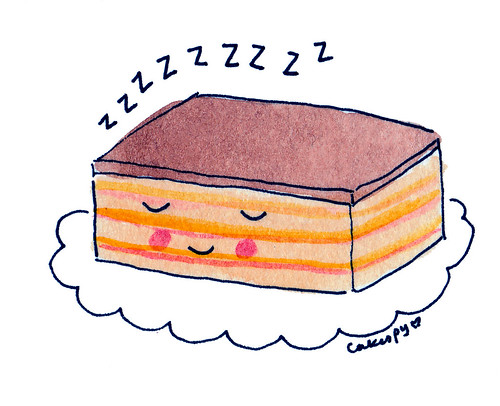
Zserbo: Per Manna Cafe, Emil Gerbeaud (Zserbo) arrived in Budapest from Paris in 1882. The signature four-layer pastry in his eponymous café, which still remains in Vörösmarty Square, is made with apricot (barak) and walnut (dios) fillings and a rich chocolate icing on top.
 Tuesday, February 2, 2010
Tuesday, February 2, 2010 
, this cookie was in high demand mid-century. As the recipe introduction notes,

 Here's the recipe:
Here's the recipe:
 Cookies,
Cookies,  cake history,
cake history,  recipes
recipes 








